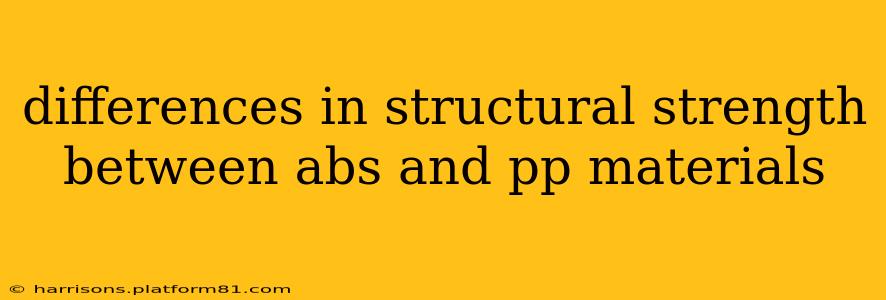Acrylonitrile Butadiene Styrene (ABS) and Polypropylene (PP) are both widely used thermoplastics, but they exhibit significant differences in their structural strength and properties. Understanding these differences is crucial for selecting the right material for a given application. This article delves into the key distinctions, exploring their strengths and weaknesses to help you make informed decisions.
What is ABS Plastic?
ABS is a terpolymer made from three monomers: acrylonitrile, butadiene, and styrene. This unique combination results in a material that boasts a good balance of properties, including high impact resistance, rigidity, and excellent chemical resistance. The butadiene component contributes to its toughness and impact resistance, while the styrene and acrylonitrile components enhance stiffness and heat resistance.
What is PP Plastic?
Polypropylene (PP) is a thermoplastic polymer known for its versatility and cost-effectiveness. It's a lightweight material with good chemical resistance and high tensile strength. However, its impact resistance can be lower than ABS, particularly at lower temperatures. Several grades of PP exist, each tailored to specific performance needs.
Comparing the Structural Strength of ABS and PP: A Detailed Look
Several factors contribute to the overall structural strength of both materials:
1. Tensile Strength:
- ABS: Offers good tensile strength, meaning it can withstand significant pulling forces before breaking. This makes it suitable for applications requiring durability and resistance to stretching.
- PP: Also possesses good tensile strength, often comparable to or even exceeding ABS in certain grades. However, the strength can be affected by temperature and the specific type of PP used.
2. Impact Strength:
- ABS: Excels in impact strength, meaning it can withstand sudden shocks and impacts without fracturing. This is a key advantage over PP in many applications.
- PP: Generally exhibits lower impact strength than ABS, particularly at lower temperatures. Modifications and additives can improve its impact resistance, but it often remains less resilient than ABS.
3. Flexural Strength:
- ABS: Shows good flexural strength (resistance to bending), making it suitable for applications requiring stiffness and resistance to deformation.
- PP: Depending on the grade and additives, PP's flexural strength can be comparable to or slightly lower than ABS.
4. Fatigue Resistance:
- ABS: Possesses moderate fatigue resistance, meaning it can withstand repeated stress cycles before failure.
- PP: Similar to ABS, PP's fatigue resistance is moderate. However, the specific grade and processing methods significantly influence its performance under cyclic loading.
5. Heat Resistance:
- ABS: Offers moderate heat resistance, suitable for applications exposed to moderate temperatures. Prolonged exposure to high temperatures can degrade its properties.
- PP: Generally exhibits better heat resistance than ABS, withstanding higher temperatures before significant degradation occurs. However, the exact heat resistance depends heavily on the specific grade of PP.
Which Material is Stronger? It Depends!
There's no single answer to the question of which material is "stronger." The best choice depends entirely on the specific application and the type of stress the material will encounter.
-
Choose ABS when: High impact resistance, good chemical resistance, and a balance of stiffness and toughness are needed. Applications like housings for electronics, automotive parts, and luggage often utilize ABS.
-
Choose PP when: Lightweight, cost-effective, and good chemical resistance are priorities. Applications where high impact resistance is less critical, such as food containers, packaging, and some automotive parts, frequently use PP.
Frequently Asked Questions (FAQ)
What are the main differences between ABS and PP in terms of structural properties?
The main differences lie in impact strength and heat resistance. ABS generally exhibits superior impact resistance, making it more suitable for applications involving shocks and impacts. PP often shows better heat resistance than ABS. Tensile and flexural strengths are comparable, depending on the specific grade of each material.
Is ABS or PP better for outdoor applications?
Both materials can be used in outdoor applications, but their suitability depends on the specific environmental conditions. ABS's superior impact resistance might make it preferable in harsh environments, while PP's superior UV resistance (in certain grades) could be more advantageous in prolonged sunlight exposure. UV stabilizers are often added to both materials to enhance their outdoor performance.
Can ABS and PP be recycled?
Yes, both ABS and PP are recyclable, although the recycling processes and end-use applications of the recycled material can vary. The success of recycling often depends on the separation and purity of the plastic streams.
Which material is more expensive?
Generally, ABS is slightly more expensive than PP due to the more complex manufacturing process and higher raw material costs.
By understanding the specific strengths and weaknesses of ABS and PP, you can choose the most appropriate material for your project, optimizing performance and cost-effectiveness. Remember that the specific properties can vary depending on the grade and additives used in the manufacturing process.
